|


|

|
|
|
Comparing Clutch/Brake Pedals and Brackets |
|
 |
|
Something that
seems to come up fairly regularly on the FORDification.com
forums are questions concerning the interchangeability of the
clutch/brake pedal pivot brackets (and the pedals
themselves) between the '67-'72 'bumpside' trucks and the
'73-'79 'dentside' trucks. Wanting to find out once and for all
if they would, I spent a good part of a day making some
comparisons of 4 different setups (Fig. 01): one each from a
'67, a '68, a '77 and a '79. What I found was very eye-opening. |
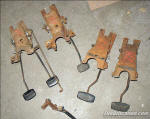
Fig. 01 |
|
|
1. '73-'79 pedal pivot brackets will NOT bolt up into a
'67-'72 truck without major dash modifications.
2. '73-'79 pedals will not easily fit the '67-'72 pedal
pivot bracket.
Some grinding can be done to make the the '73-'77 pieces
fit, but the '78-'79 pedals will just plain not work.
3. (Some) '78-'79 power brake boosters will NOT fit '67-'72 trucks.
The '73-'77 versions will fit just fine.
4. '78-'79 power brake boosters will only fit '73-'77 trucks
if the '73-'77 brake pedal is also used.
5. 1967 trucks use a one-year-only pivot bracket and booster
combination.
|
|
|
Let's examine each of these
five points in greater detail.
|
 |
|
1. '73-'79 pedal pivot brackets will NOT bolt up into
a '67-'72 truck without major dash modifications. |
|
The '73-'79 pedal pivot brackets are identical to the
'67-'72 versions where it mounts to the firewall, but that's
where the similarities end. The '73-up pieces are much wider
at the front mounting point, and mount to the steering
column brace behind the dash instead of the bottom lip of
the dash like the '72-older pieces do. |
|
In Fig. 02, we can see the differences in the front mounting
of a '68 vs. a '77 pivot bracket. The yellow arrows point to
the brackets' front mounting points. The '68 piece mounts to
the bottom of the dash, whereas the much-wider '77 piece
mounts higher up behind the dash to the dash braces. Because
of the width difference, that '77 piece won't even come
close to fitting in the steering column notch in a bumpside
dash (see Figs. 5 and 6 below). |

Fig. 02 |
|
Here's another view of the two pivot brackets. The
differences in width and mounting locations are obvious.
Some fairly serious surgery would be required to the
'bumpside' dash to fit the 'dentside' pivot bracket. Not
only would the 'bumpside's' steering column notch have to be
enlarged and reinforced, but additional work would be
required to the steering column/dash brace to allow the
'dentside' bracket to be attached. |
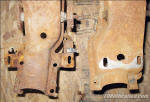
Fig. 03 |
|
This is a cut-away view of a bumpside dash, just so you can
see the orientation of the pedal pivot bracket to the dash
and the steering column brace behind it. The left side of
the lower dash panel hasn't been touched here, and you can
see how little room there is between the pivot bracket and
the lower dash. |

Fig. 04 |
|

Fig. 05 |
Here are two more views of the bumpside dash
just for visual purposes. Fig. 05 is looking
down from above (through the instrument
panel hole), Fig. 06 is looking up from the
cab floor.
|

Fig. 06 |
|
|
Fig. 07 shows the dentside dash's steering column notch.
When comparing it to Figs. 05 and 06 above, you can see the
notch is much wider. |

Fig. 07 |
 |
|
2. '73-'79 pedals will not easily fit the '67-'72 pedal
pivot bracket. |
|
In order to help you understand why the '73-up pedals won't
fit the earlier pivot brackets, lets take a quick look at
each era's pedals and their respective pivot points in the
bracket. |
|
Fig. 08 shows the pivot end of a '68 brake pedal, with it's
two nylon bushings.... |

Fig. 08 |
|
...and here's the '68 pivot bracket. You can see that the
two aluminum bushings (yellow arrows) that are crimped into
large holes in the bracket. Another nylon bushing fits
inside each of the aluminum bushings. |

Fig. 09 |
|
OK, now let's look at the '77 pedal setup. The inside
diameter of the pedal's pivot end is the same as the
'72-older pieces, and the two identical nylon bushings fit
into each end. Then things change. A metal sleeve is
inserted through the bushings and is then held onto the
pivot bracket with a long bolt and nut. Note the metal
spring-washer used on one side. |

Fig. 10 |
|
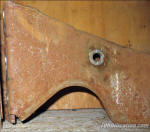
Fig. 11 |
Ford did away with the larger aluminum bushings
in '73 due to problems with rapid wear and their
coming loose in the bracket. There is just one
small hole in the '73-'77 pivot bracket to hold
the pivot bolt. |

Fig. 12 |
|
|
Now that we know how each pedal pivots in their respective
brackets, let's try to swap them around. Fig. 13 (bad luck
number!) shows the problem encountered when trying to
install a '77 pedal in a '68 bracket. You can see that the
pedal pivot is hitting the '68 bracket's aluminum bushings.
Because the '73-up brackets didn't use the aluminum
bushings, the pivot end of the '73-up pedal is wider to
compensate. |

Fig. 13 |
|
OK, just for kicks, let's try installing the '68 pedal in
the '77 bracket. As you can see, the pivot end of the pedal
is way too narrow. |
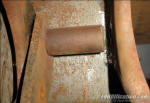
Fig. 14 |
|
Fig. 15 illustrates the difference in width between the
pivot ends of the two generations of brake pedals.
The '67-'72 pedal pivot ends are 2-7/8" wide, while the
'73-'79 pivot ends measure 3-1/8". |

Fig. 15 |
|
At the beginning of this section I said "the '73-'79 pedals
will not easily fit the '67-'72 pedal pivot bracket"...but
with a little grinding, some the '73-'77 pieces will
fit. (Some of the '78-'79 pedals will not work...period. More on
that below). All you have to do is remove the metal sleeve
and discard it, and then carefully grind the ends of the
pedal's 3-1/8"-wide pivot down to 2-7/8", so that
it'll fit in-between the '67-'72 bracket's aluminum
bushings. Then use the '67-'72 pin to hang the pedal. You'll
also have to possibly have to do some minor re-engineering
to the brake light switch bracket to get it to line up
correctly.
Also, keep in mind that '73-up trucks equipped with an
automatic transmission had a wider brake pedal, and
therefore shouldn't be used in conjunction with a clutch
pedal.
From '73-'76 there were four different available brake
pedals...two designed for cruise control applications and
two without. There were 8 different brake pedals for '77 to
'79 F100-F350 trucks, based on what style brakes or booster
they had or if they had cruise control. The 8 different
'77-'79 pedals include the 4 earlier ones, as their use was
continued on some applications. |
 |
|
3. Some '78-'79 power brake boosters will NOT fit '67-'72 trucks.
The '73-'77 versions will fit just fine.
4. '78-'79 power brake boosters will only fit '73-'77 trucks
if the '73-'77 brake pedal is also used. |
|
These two go hand-in-hand, so we'll look at them together. |
|
Ford used two different style of vacuum booster brackets on
the '73-'79 trucks, depending on the application. Usually
the standard brackets were used, but in some cases they
installed a cantilever-style bracket/linkage as shown in
Fig. 16, which lifted the booster up several inches to clear
the engine's valve covers. However, both bracket styles will
fit and work with '67-'72 trucks, providing they come from a
'77-older truck. The unit pictured here is a '77 unit... |

Fig. 16 |
|
...and here's a shot of it installed on the '68 pedal and
pivot bracket. The only difference between this shot and an
actual installation will be the negligible thickness (app.
1/8") of the firewall between the booster and the pivot
bracket. I didn't show the booster installed on the '77
pivot bracket, since the two were together on the junker
truck I pulled them from, so I know they'll fit just
fine...and the installation is identical. |

Fig. 17 |
|
OK, now let's try installing this '77 booster on a '78 pedal
pivot bracket. Hmmmm....Houston, we have a problem! As you
can see, the booster arm is too long and ends up being too
high to properly engage the brake pedal. What's going on??
Well, that's easily explained....and is also why the '78-'79
booster won't work. |

Fig. 18 |
|
At first glance, the '78 pedal pivot bracket (on the right)
appears to be almost identical to the '77 piece, with the
only apparent difference being the forward mounting point.
The '73-'77 pieces had slots whereas the '78-'79 pieces just
had round holes. |

Fig. 19 |
|
However, when you start looking closer, you can see how the
'78-'79 brake pedal pivot point is 2" farther forward
(towards the firewall). The yellow arrow points to a second
pivot hole...which is positioned identical to the '77 pivot
bracket. In other words, the factory drilled a second hole
2" farther back and slightly up from the original and
installed the brake pedal there....which means, of course,
that the brake pedal also had to be re-engineered to line
up. |
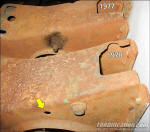
Fig. 20 |
|
Because the new pivot hole was raised slightly, the brake
pedal had to be slightly longer to enable the pedal pad to
end up in the same place.... |

Fig.
21 |
|
...and it also meant that the booster rod would connect at a
lower point on the pedal arm, so the hole had to be lowered.
Measuring from the center of the pedal's pivot to the center
of the booster rod hole on the '77 pedal we get a
measurement of 2-1/4", and a measurement of 4" on the '78
pedal. In Fig. 22 the difference is very noticeable. |

Fig.
22 |
|
OK, since the '78 pivot bracket appears to also be drilled
for the '77-older pedals, let's try installing the '77 pedal
and see how it lines up. Bingo! It lines up perfectly. While
this information isn't really helpful to the bumpside owner,
at least the dentside owners now know that in order to use a
'77-earlier booster on a '78-'79 pivot bracket, you have to
use the '77-earlier pedal and mount it in the forward pivot
hole. |

Fig.
23 |
|
So how is the '78-'79 booster different? Well, the first
obvious difference is the curved booster rod, as shown in
Fig. 24. Also, notice how the booster's mounting brackets
don't mount the booster square to the firewall....the top of
the brackets are narrower than the bottom. |

Fig. 24 |
|
At this point, I cannot say absolutely that the
'78-'79 booster will not work with the '77-earlier trucks,
because the picture of the '78 booster in Fig. 24 was taken
a while back and since sold, so I no longer have it to
trial-fit it to an earlier pivot bracket for absolute
verification. However, when taking these pictures I suddenly
recalled that the person I sold this booster setup to
several years ago e-mailed me back after receiving it,
telling me that the booster rod was about 2" too short.
Since I wasn't aware of the differences at that time, I had
to tell him I didn't know what was going on. He told me he'd
investigate further, but I never heard back from him.
Therefore, I'm not sure if the '78-'79 booster didn't work
because of the curved pushrod or the different angled
brackets...or a combination of the two.
So at this point, I'm ready to say that I'm 98% sure
that the '78-'79 boosters will not work with earlier
pivot brackets. However, there still are a few variables
that I need to try to figure out:
1) Will the '77-earlier brackets bolt up to the
'78-'79 booster?
2) Can the '78-'79 booster's curved pushrod be
removed to install a straight rod (or cantilever-style)
setup?
It's possible (though probably a very remote possibility)
that if the 77-earlier booster brackets and pushrod were
installed on the '78-'79 booster, that would allow it to be
installed on the '77-earlier trucks. However, even if that
does work, that's a lot of work to go through, so
until I learn more specifics about the '78-'79 booster, I
will advise '67-'72 truck owners to avoid them. Owners of
'73-'77 trucks will be advised that the '78-'79 booster can
be used ONLY in conjunction with the '78-'79 pedal
pivot bracket. If you can contribute any information to
clear up the use of '78-'79 boosters on a '77-earlier truck,
please
e-mail me.
UPDATE: I did hear back from someone with experience
in the '73-'79 trucks, who wrote the following regarding
'78-'79 power brake boosters:
"...some are direct bolt-in and some others are not. The
change was actually in '77 and in the '77-'79 time-frame
Ford used a huge number of different boosters and brake
pedals. Why they made so many different ones I do not know
but most F250 dual diaphragm boosters will bolt in but the
F100 and F350 stuff never seems to, based on my experience." |
 |
|
5. 1967 trucks use a one-year-only pivot bracket and booster
combination. |
|
OK, after hearing about the experiences from others who were
having problems attempting to swap power brake boosters into
their '67s, I decided to find out once and for all what the
problems were....and here's what I found out: |
|
The pedal pivot bracket under the dash is another one of
those strange '67-only pieces. As you can see in Fig. 25,
the '67 (bottom) pedals' pivot point is 3⅞ inches inches
from the firewall to the middle of the pivot pin, whereas
the '68-'72 assembly (top) is 5 inches from the firewall. |

Fig. 25 |
|
So I decided to go ahead and mount up a '68-'77 power brake
booster to the '67 assembly to see what would happen. The
only difference to this in an actual installation would be
the negligible 1/8" thickness of the firewall. |

Fig.
26 |
|
....and here's the end result. As you can see, the '68-up
brake booster's pushrod is going to be about an inch too
long, even with the brake pedal as far forward as it can go.
Conversely, installing a '67 booster (with it's shorter
pushrod) to a '68-'72 bracket will require the brake pedal
to drop down to within 2" from the floor to be attached,
rendering your brakes virtually unusable. |

Fig.
27 |
|
So...here's the final verdict for '67 owners. If you're
wanting to install a power booster on your '67, here are
your options:
1) Use the '67 Bendix-style brake booster with
your '67 pedal assembly bracket; or
2) Swap a '68-'72 pedal pivot bracket into your
'67, and then use a '68-'77 brake booster; or
3) Drop your '67 brake pedal out and weld a 1"
extension tab onto the rear (towards the driver) edge of
the pedal, drill a hole for the booster rod, and then go
ahead use the '68-'77 booster.
By far, #2 would be the cheapest, fastest and easiest route, and the
one I recommend. |
|
 |

Want to link to
this site? Please save this banner to your hard drive to place on your
webpage.
The correct link to use is
http://www.fordification.com
|